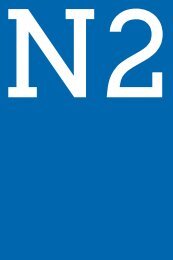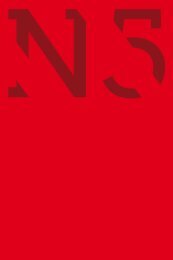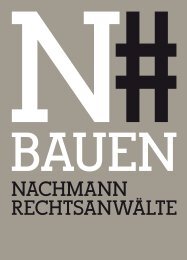uNseR maNN IN euRopa
uNseR maNN IN euRopa
uNseR maNN IN euRopa
Sie wollen auch ein ePaper? Erhöhen Sie die Reichweite Ihrer Titel.
YUMPU macht aus Druck-PDFs automatisch weboptimierte ePaper, die Google liebt.
wall of light dog, 2000; oil on linen; 74.4 x 79.9" (189 x 203 cm)<br />
public Collection: Staatliche Museen Kassel, Neue Galerie, Kassel, Germany<br />
Cezanne an: Alles müll! Entscheidend ist:<br />
sie haben durchgehalten.“<br />
Scully hat durchgehalten und dabei<br />
seine faszinierende Bildsprache entwickelt.<br />
Er überrascht mich völlig, als er – von<br />
sich aus – bereit ist, einige Aspekte dieser<br />
Sprache dem außenstehenden Besucher zu<br />
eröffnen. Ein geradezu unerhörter Vorgang,<br />
den man höchst selten bei einem Künstler<br />
dieses Kalibers erleben darf. Sind doch die<br />
meisten Künstler – und besonders diejenigen,<br />
die sich an erster Stelle selbst dafür halten<br />
– meistens der meinung, der Betrachter<br />
müsse sich die Aussagen der Bilder selbst<br />
” erarbeiten“. Nicht so Scully. Was wiederum<br />
beweist, dass er nicht nur einfach in einer<br />
für ihn typischen Weise malt, sondern das<br />
Geistige in seiner Kunst sehr wohl kennt –<br />
und formulieren kann.<br />
” Auf diesem Bild“, sagt er und zeigt<br />
auf eines seiner lieblingsbilder mit dem<br />
Namen Wall of light Dog’, gibt es einen<br />
’ ”<br />
licht-blauen horizontalen Streifen auf der<br />
rechten Seite. Dieser Streifen unterscheidet<br />
sich vom Rest des Bildes. Es gibt aber noch<br />
einen anderen oben links von ähnlicher Farbe.<br />
Er ist vertikal. Der Vertikale ist auf seine<br />
Weise mächtiger als der Horizontale. Er ist<br />
aggressiver, weil er Wachstum und aufrecht<br />
stehende Figuren impliziert. Der Horizontale<br />
dagegen ist eine innere Horizontlinie.“ Bei<br />
der Erwähnung der ruhigeren Ausstrahlung<br />
des waagerechten Streifens, wird auch seine<br />
Stimme leiser, noch sanfter, geradezu melan-<br />
person, the paintings now have more melancholia,<br />
more pathos, bigger heart, bigger body and a<br />
very beautiful relationship with this issue of the<br />
edge, the way things share a surface. So these<br />
issues of power and conciliation and cutting are<br />
running all the way through my work. They are<br />
the subjects of my work. It’s a kind of spiritual<br />
humanism I think.<br />
? But the lowest layer must be dry.<br />
Because sometimes you can see different<br />
colours coming through on the edges...<br />
! Yes, it depends how long I work on<br />
the painting. So sometimes – for example – if<br />
I paint a painting quick, I just paint it quick.<br />
Then I leave it. Some give me a chance to look<br />
at the drawing. Give me the chance to change<br />
the drawing. That happens now and again - that<br />
I change the drawing. Not so often. But it does<br />
give me the option. And then you will see that<br />
these colours are being painted ON TOP OF...<br />
but they are not mixing. So they are registering<br />
as pure colour around the edges. That gives you<br />
the sense of context and subtext – as I said before.<br />
And SuBTEXT is influencing the CONTEXT<br />
in which all these other things are existing side<br />
by side. In a manner it’s a way of getting a sort<br />
of narrative without illusionism. You know they<br />
are really flat. I don’t really paint space. I am not<br />
interested in painting space. I paint things. And<br />
the blocks are allways things. And I paint them.<br />
So that they sit next to other BlOCKS, that<br />
are also TH<strong>IN</strong>GS. So everything has the status<br />
in my work of a positive. I don’t paint negative<br />
space. like figure ground paintings for example.<br />
Everything has to be positive.<br />
Das Handy klingelt – er führt das Gespräch<br />
in Spanisch, geht in den anderen Raum<br />
zu seiner Frau.<br />
I don’t make sort of obvious hierachies<br />
in my paintings. So everything that is in the<br />
painting has it’s own various kind of power. To<br />
hold it’s own place in the painting. In the way,<br />
that it’s painted in – the painting. So, you know,<br />
one thing can be smaller than another thing, or<br />
lower down in the painting etcetera etcetera. But<br />
they all assert themselves. That’s what I am doing.<br />
I’m making something that has a kind of ...<br />
democracy in it. And there is no clear hierarchy.<br />
But at the same time as that I try if possible to<br />
avoid falling into what is sometimes referred to<br />
as ” all over painting“. I certainly avoid monochrome<br />
painting, which I think is an option that<br />
is historically played out. I don’t see what you<br />
can do with it any more. It’s historically defunct.<br />
So, I have composition in my painting.<br />
I have drawing in my painting. I have drama in<br />
my painting. I have emotion in it. I have reference<br />
to the landscape, reference to the figure<br />
and relationships – the central human problem<br />
– so, I have a lot in the paintings. So, I haven’t<br />
sacrificed what we might refer to as... the human<br />
need for some content, some sense of figure,<br />
some sense of orientation.<br />
? when you start a painting, you<br />
have four sides. do you make proportions<br />
on the sides of the frame – for instance<br />
three up, four right, six left and four on<br />
the ground ? or do you sketch already the<br />
fields?<br />
! I go inside straight away. Depending<br />
where I want to start. I can start anywhere.<br />
? so you start – let us say – with<br />
the bar on the left side? and then it’s<br />
growing?<br />
! Well, I might draw a painting out<br />
with charcoal. But I don’t spend so much time<br />
drawing it out, because I can paint the bars into<br />
place – so to speak – and I can make them be<br />
more or less anywhere. Depending on how I<br />
paint them, depending on what colour they are.<br />
So all this is open to articulation as the painting<br />
progresses. And you can see with this painting<br />
- that we are looking at now, which is one of my<br />
favorites, called ” Wall of light Dog“ - it has one<br />
light blue horizontal bar on the right side in the<br />
middle. And that bar kind of distinquishes itself<br />
from the rest of the painting. And there is another<br />
one of a similar colour on the top left. It’s<br />
a vertical. So the vertical in a way is more powerful<br />
than the horizontal is. It’s more aggressive<br />
because it implies growth and standing figures.<br />
And the horizontal is an internal horizon line.<br />
So you can see: it’s the same colour - in terms<br />
of source - but it manifests itself differently. Or<br />
one get’s the sense that it’s the same colour at<br />
different times of the day. Or night. And the<br />
colour on the top left - which is the vertical - is<br />
moving towards night. It’s deeper and more<br />
reserved. And the same source of colour on the<br />
right hand side horizontally is more lit up. It’s









